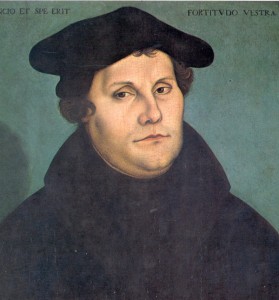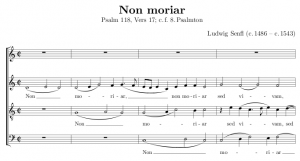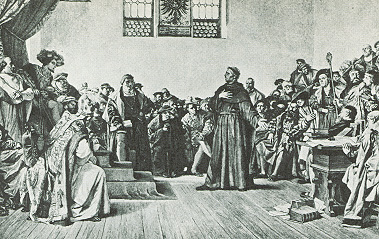An unfinished masterpiece
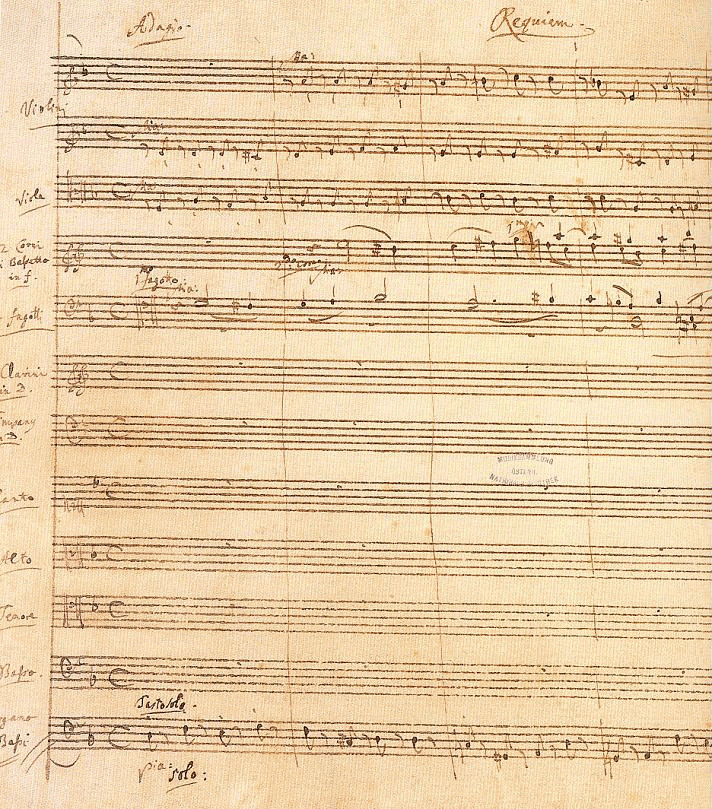
Mozart
Wolfgang Amadeus Mozart was born in Salzburg, Austria in 1756. His musical talent was noticed very early. His father, Leopold Mozart, taught him music theory, keyboard technique, and the violin. (Cormican 5) He toured Europe with his father, playing for many royal families. (Cormican 8) On this tour, he absorbed the national styles of music and was impacted by many composers in the countries he traveled through. (Grout, Burkholder and Palisca 548) Throughout his life he composed many genres of music, primarily selling his works for income. He never had long-term stable employment unlike many other composers of his day. (Grout, Burkholder and Palisca 552) He died in Vienna in 1791.
Mozart’s Requiem Mass
The Requiem was anonymously commissioned by Count Walsegg in July 1791 as a memorial to his wife who had recently died. Mozart was working on The Magic Flute at the time and didn’t start work on the Requiem until fall of that year. He fell sick as he was working on the piece, and died before it was completed. At Mozart’s death, the Requiem Aeternam was complete as well as the figured bass, choral, and important instrumental parts for the first 8 measures of Lacrimosa. Parts of the Domine Jesu Christe and Hostias had been written. (Eisen) Franz Xaver Süssmayr, Mozart’s pupil who had helped Mozart in his last days, finished the Requiem.
A requiem is a mass for the dead as in the Latin, Missa Pro Defunctis. It gets its name from the first line of the Introit, “Requiem aeternam dona eis, Domine“ meaning “Eternal rest grant them, O Lord“. The liturgy is a modified version of the Roman Catholic mass. (Wikimedia Foundation, Inc) The text was standardized during the Council of Trent, and codified by Pope Pius V in 1570. (Wolff 66)
Introit
The Requiem starts with the Introit. The text is a prayer for the deceased that they would be raised on the Day of Judgment. The text is as follows:
Original Latin:
Requiem æternam dona eis, Domine,
et lux perpetua luceat eis.
Te decet hymnus Deus, in Sion,
et tibi reddetur votum in Ierusalem.
Exaudi orationem meam;
ad te omnis caro veniet.
Requiem æternam dona eis, Domine,
et lux perpetua luceat eis.English Translation:
Eternal rest grant unto them, O Lord,
and let perpetual light shine upon them.
A hymn becomes you, O God, in Zion,
and to you shall a vow be repaid in Jerusalem.
Hear my prayer;
to you shall all flesh come.
Eternal rest grant unto them, O Lord,
and let perpetual light shine upon them.
(Text and translation taken from Wikipedia unless otherwise noted.)
The text is calm and serene, and Mozart’s music reflects this. The vocal score is set in the style of Baroque counterpoint (Losel 366) and is marked Adagio.
Next in the mass is the Kyrie. It is the only Greek text in the mass. The text is “Kyrie elesion, Christe elesion, Kyrie elesion” meaning “Lord have Mercy, Christ have mercy, Lord have mercy”. Traditionally, each line would be sung three times. Mozart set the Kyrie as a large double fugue with the first subject using the text “Kyrie elesion” and the second subject using “Christe elesion”.
In a standard requiem of the time, the Graduale and Tract would be sung next, but as Mozart omitted them, they will not be discussed here.
Dies Irae
An important part of the requiem mass is the Sequence, a text that is sung before the Gospel. Normally, this would vary based on the church year, but in the requiem a unique Latin hymn was used called the Dies Irae. The Dies Irae was written around 1250 by Thomas of Celano, an early Franciscan monk, and describes the Day of Judgment. (Caldwell and Boyd) It is a long work containing nineteen verses and comprises the bulk of Mozart’s Requiem. Mozart divided the Dies Irae into six movements, titled by the first few words in the movement.
The first movement of the sequence uses the first two verses of the Dies Irae:
Original Latin:
Dies iræ! dies illa
Solvet sæclum in favilla:
Teste David cum Sibylla!Quantus tremor est futurus,
Quando iudex est venturus,
Cuncta stricte discussurus!English translation:
The day of wrath, that day
Will dissolve the world in ashes
As foretold by David and the sibyl!How much tremor there will be,
when the judge will come,
investigating everything strictly!
The Dies Irae is an incredible example of Mozart’s command of text painting and orchestration. It is angry and vicious music with off-beat rhythms, running strings, and brass fanfares. It is marked Allegro Assai, meaning very fast. Mostly homophonic, the words Dies Irae (Day of Wrath) signal a timpani roll which resembles thunder (mm. 2, 4, 23, and 25). The words Quantus tremor est futurus (How much tremor there will be) are a series of up and down scale steps in the bass voice (mm. 49), and Cuncta stricte discussurus (Investigating everything strictly) is slower and deliberate (mm. 37).
The next movement, titled Tuba, Mirum, uses the next five verses of text:
Original Latin:
Tuba, mirum spargens sonum
Per sepulchra regionum,
Coget omnes ante thronum.Mors stupebit, et natura,
Cum resurget creatura,
Iudicanti responsura.Liber scriptus proferetur,
In quo totum continetur,
Unde mundus iudicetur.Iudex ergo cum sedebit,
Quidquid latet, apparebit:
Nil inultum remanebit.Quid sum miser tunc dicturus?
Quem patronum rogaturus,
Cum vix iustus sit securus?English Translation:
The trumpet, scattering a wondrous sound
through the sepulchres of the regions,
will summon all before the throne.Death and nature will marvel,
when the creature arises,
to respond to the Judge.The written book will be brought forth,
in which all is contained,
from which the world shall be judged.When therefore the judge will sit,
whatever hides will appear:
nothing will remain unpunished.What am I, miserable, then to say?
Which patron to ask,
When the just may hardly be sure?
The text describes the Day of Judgment as depicted in Revelation. It uses a trombone obbligato in reference to the trumpet’s call of judgment, a musical reference also used in one of Mozart’s early works, the oratorio “The Obligation of the First Commandment”, K. 35 (Cormican 17) It only uses soloists. The first verse is in major, marked Andante, and uses a bass soloist with trombone obbligato. The second and third verses are sung by the tenor soloist. There is a shift in the mood with faster strings and a minor mode (mm. 18). The third verse is sung by the alto soloist (mm. 34). The fourth verse switches back to major and is sung by the soprano (mm. 40). The final line is repeated by all four soloists in four-part harmony (mm. 51).
The next verse is a plea for mercy:
Original Latin:
Rex tremendæ maiestatis,
Qui salvandos salvas gratis,
Salva me, fons pietatis.English Translation:
King of tremendous majesty,
who freely saves those that have to be saved,
Save me, source of mercy.
The chorus enters with a homophonic section, reminiscent of the French overture style, punctuating the first line of the text and signifying royalty. The second line of text is contrapuntal (mm. 7). The final line is quiet and slow, a tender plea for mercy (mm. 18).
The next movement is quite long and includes the next seven verses of the Dies Irae:
Original Latin:
Recordare, Iesu pie,
Quod sum causa tuæ viæ:
Ne me perdas illa die.Quærens me, sedisti lassus:
Redemisti Crucem passus:
Tantus labor non sit cassus.Iuste iudex ultionis,
Donum fac remissionis
Ante diem rationis.Ingemisco, tamquam reus:
Culpa rubet vultus meus:
Supplicanti parce, Deus.Qui Mariam absolvisti,
Et latronem exaudisti,
Mihi quoque spem dedisti.Preces meæ non sunt dignæ:
Sed tu bonus fac benigne,
Ne perenni cremer igne.Inter oves locum præsta,
Et ab hædis me sequestra,
Statuens in parte dextra.English Translation:
Remember, merciful Jesus,
that I am the cause of thy way:
lest thou lose me in that day.Seeking me, thou sat tired:
thou redeemed [me] having suffered the Cross:
let not so much hardship be lost.Just judge of revenge,
give the gift of remission
before the day of reckoning.I sigh, like the guilty one:
my face reddens in guilt:
Spare the supplicating one, God.Thou who absolved Mary,
and heard the robber,
Gives hope to me, too.My prayers are not worthy:
however, thou, Good [Lord], do good,
lest I am burned up by eternal fire.Grant me a place among the sheep,
and take me out from among the goats,
Setting me on the right side.
This movement uses ritornello form with the music at the beginning appearing throughout the work at the transition between sections. The ritornello form also underscores the idea of remembrance used in the text. The form also doubles as a loose rondo form, with the music for the first verse being used in the third verse and, with slight modification, the last two verses combined. The last line of the penultimate verse foreshadows the music of the next section. The text is similar – both speak of being burned by eternal fire – and the motive used in the strings is similar.
The next two verses represent a change in the music:
Original Latin:
Confutatis maledictis,
Flammis acribus addictis:
Voca me cum benedictis.Oro supplex et acclinis,
Cor contritum quasi cinis:
Gere curam mei finis.English Translation:
Once the cursed have been rebuked,
sentenced to rancorous flames:
Call thou me with the blessed.I meekly and humbly pray,
[my] heart is as crushed as the ashes:
Perform the healing of mine end.
This section starts with the low voices and strings singing the first two lines. The tone and rhythm is angry representing the cursed in hell. The high strings and voices then sing a quiet homophonic plea to be called with the blessed to heaven. (mm. 7, 17) (Losel 368) All voices then join in a quiet, homophonic section describing the humble prayer of the sinner, whose heart is crushed, asking for healing (mm. 26).
The final two verses of the sequence conclude the prayer for the deceased:
Original Latin:
Lacrimosa dies illa,
qua resurget ex favilla
iudicandus homo reus.
Huic ergo parce, Deus:Pie Jesu Domine,
dona eis requiem. Amen.English Translation:
Tearful will be that day,
on which from the ashes arises
the guilty man who is to be judged.
Spare him therefore, God.Merciful Lord Jesus,
grant them rest. Amen.
The strings use a motive throughout representing tears. The lines “qua resurget ex favilla iudicandus homo reus” start softly and gradually get louder as they climb in pitch clearly showing the guilty rising from the ashes (mm. 5-8). The climb in pitch climaxes on the word Reus, the Latin word for guilty (mm. 8).
There is some evidence that Mozart intended an Amen fugue for the end of the sequence. A sketch of the fugue was found in the 1960s. The primary subject of the fugue is the main theme from the beginning of the requiem in strict inversion. (Maunder 173) (Wikimedia Foundation, Inc)
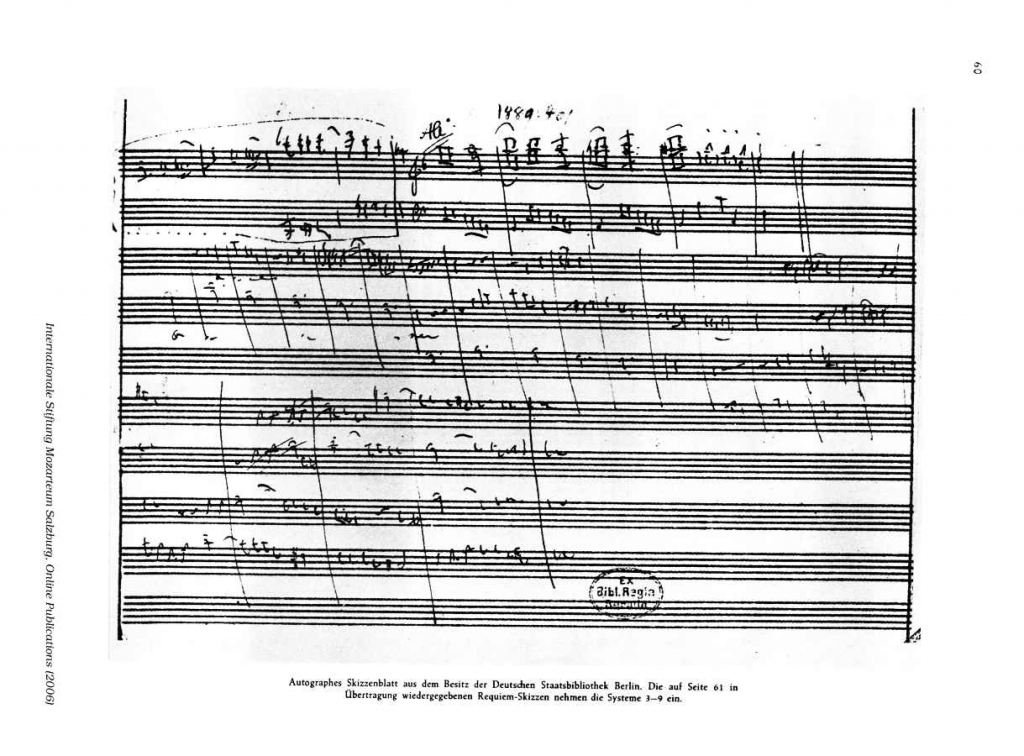
Offertory
Original Latin:
Domine Jesu Christe, Rex gloriæ,
libera animas omnium fidelium defunctorum
de pœnis inferni et de profundo lacu.
Libera eas de ore leonis,
ne absorbeat eas tartarus,
ne cadant in obscurum;
sed signifer sanctus Michæl
repræsentet eas in lucem sanctam,
quam olim Abrahæ promisisti et semini eius.English Translation:
Lord Jesus Christ, King of glory,
free the souls of all the faithful departed
from infernal punishment and the deep pit.
Free them from the mouth of the lion;
do not let Tartarus swallow them,
nor let them fall into darkness;
but may the standard-bearer Saint Michael,
lead them into the holy light
which you once promised to Abraham and his seed.
The first two lines have a lyrical melody over a primarily homophonic texture. They are followed by the third line; a disjunct melody with many melodic leaps. The fourth line is a loose polyphonic reworking of the material in the first two lines. The fifth and sixth lines develop the disjunct leaps from line three. Lines seven and eight are a canon built on the melody from lines one and two, sung by soloists. The canon is built on descending fifths, the soprano starts with the melody on G, the alto follows with the melody on C, the tenor follows with the melody on F, and finally the bass comes in on B-flat. (Wolff 92-93)
Finally, there is a wonderful fugue using the last line of text. Mozart uses fugue and imitative polyphony throughout the requiem when the text refers to the Old Testament. In an interesting contrast, he is using the older baroque style for older characters. (Wolff 110) The fugue returns in the next movement, Hostias, where the last line is the same.
Original Latin:
Hostias et preces tibi, Domine,
laudis offerimus;
tu suscipe pro animabus illis,
quarum hodie memoriam facimus.
Fac eas, Domine, de morte transire ad vitam.
Quam olim Abrahæ promisisti et semini eius.English Translation:
O Lord, we offer You
sacrifices and prayers of praise;
accept them on behalf of those souls
whom we remember today.
Let them, O Lord, pass over from death to life,
as you once promised to Abraham and his seed.
Hostias is slow and homophonic, quite a contrast from the previous movement. The first four lines of text are repeated twice and then the fifth line is used, stylistically similar to the first four. The fifth line ends outlining a D-major triad which sets up the return to G minor for the Quam olim fugue indicated by the words “Quam olim da capo“.
Sanctus
Both movements of the Sanctus appear to be composed entirely by Süssmayr without any of Mozart’s sketches to assist him. (Maunder ch. 5-6)
Original Latin:
Sanctus, Sanctus, Sanctus,
Dominus Deus Sabaoth;
pleni sunt caeli et terra gloria tua.
Hosanna in excelsis.English Translation:
Holy, Holy, Holy,
Lord God of Hosts;
Heaven and earth are full of your glory.
Hosanna in the highest.
The text of the Sanctus is taken from Isaiah 6:3, describing the angels’ song in front of God’s throne. (Wikimedia Foundation, Inc.) It is arranged homophonically, using large chords to symbolize the angel choir. The fourth line is a short fugue, repeated for the same text in the Benedictus.
Original Latin:
Benedictus qui venit in nomine Domini.
Hosanna in excelsis.English Translation:
Blessed is he who comes in the name of the Lord.
Hosanna in the highest.
The text of the Benedictus is from Matthew 21:9 which describes the entry of Jesus into Jerusalem for the Passover feast. (Wikimedia Foundation, Inc.) The music is calm and serene. Polyphonic in nature, it only uses the soloists, developing a main idea throughout. The texture is light and airy. It can be divided into two parts. In the first part, the women lead, with the alto starting and the soprano picking up the theme and embellishing it before entering a section of four part polyphony. In the second section, the roles are reversed with the bass starting and the tenor picking up the melody. Both sections are essentially the same with slight differences for embellishment. Both sections end with an interlude composed of alternating winds and strings. The movement ends with a repeat of the fugue from the previous movement.
Agnus Dei
Original Latin:
Agnus Dei, qui tollis peccata mundi, dona eis requiem,
Agnus Dei, qui tollis peccata mundi, dona eis requiem,
Agnus Dei, qui tollis peccata mundi, dona eis requiem sempiternam.English Translation:
Lamb of God, who takes away the sins of the world, grant them rest,
Lamb of God, who takes away the sins of the world, grant them rest,
Lamb of God, who takes away the sins of the world, grant them eternal rest.
A traditional part of the mass ordinary, the Agnus Dei is modified for the requiem by replacing the words “have mercy on us“, with “grant them rest“. This movement was likely based on a sketch by Mozart (Maunder 58), now lost. The threefold repetition is begun each time with the words “Agnus Dei, qui tollis peccata mundi“, marked forte and the words “dona eis requiem“ marked piano. The final time, a quiet section on the word “sempiternam” ends in F, the relative major of d minor in which the rest of the movement is set.
Communion
Original Latin:
Lux æterna luceat eis, Domine,
cum sanctis tuis in æternum,
quia pius es.
Requiem æternam dona eis, Domine;
et lux perpetua luceat eis ;
cum Sanctis tuis in æternum,
quia pius esEnglish Translation:
May everlasting light shine upon them, O Lord,
with your Saints forever,
for you are kind.
Grant them eternal rest, O Lord,
and may everlasting light shine upon them.
with your Saints forever,
for you are merciful.
Lux æterna is a repeat of the opening Requiem æternam movement. It was usual at the time to repeat the opening movement’s music at the end of a requiem mass, an example being Michael Haydn’s Requiem in C minor, written twenty years earlier. (Wolff 110) The two sections of the first movement are repeated in reverse order, starting in major and then going to minor. The Kyrie fugue is also repeated using the text “cum Sanctis tuis in æternum, quia pius es”. Interestingly, the entire requiem ends on an open fifth using only the notes D and A.
Would Mozart have ended this work with an open fifth? We will never know. It illustrates the paradox of this incomplete work yet which feels and sounds so complete. It gives a timeless witness to Mozart’s faith and trust in his Savior who would “Call thou me with the blessed”. Nothing more needed to be said.
Works Cited
Caldwell, John and Malcolm Boyd. Dies irae. n.d. 18 April 2010 <http://www.oxfordmusiconline.com/subscriber/article/grove/music/40040>.
Cormican, Brendan. Mozart’s Death – Mozart’s Requiem. Belfast: The Amadeus Press, 1991.
Eisen, Cliff, et al. Mozart. n.d. 18 April 2010 <http://www.oxfordmusiconline.com/subscriber/article/grove/music/40258pg3>.
Grout, Donald Jay, J. Peter Burkholder and Claude V. Palisca. A History of Western Music. 8th. New York: W. W. Norton and Company, 2010.
Losel, Steffen. ““May Such Great Effort Not Be in Vain”: Mozart on Divine Love, Judgement, and Retribution.” The Journal of Religion 89.3 (2009): 361-400.
Maunder, Richard. Mozart’s Requiem: On Preparing A New Edition. New York: Oxford University Press, 1988.
Mozart, Wolfgang Amadeus. “Requiem, K. 262.” 1932. IMSLP / Petrucci Music Library. 1 May 2010 <http://imslp.org/wiki/Requiem,_K.626_%28Mozart,_Wolfgang_Amadeus%29>.
—. “Requiem, K. 262.” 1965. Digitale Mozart-Edition. Nowak. 1 May 2010 <http://dme.mozarteum.at/DME/nma/nma_cont.php?vsep=13&gen=edition&l=1&p1=58>.
Tomowa-Sintow, Anna, et al. “Requiem, K. 262.” cond. Herbert von Karajan. By Wolfgang Amadeus Mozart. Berlin: Deutsche Grammophon, 1976.
Wikimedia Foundation, Inc. Dies Irae. 22 July 2004. 17 April 2010 <http://en.wikipedia.org/wiki/Dies_Irae>.
—. Requiem. 22 July 2004. 17 April 2010 <http://en.wikipedia.org/wiki/Requiem>.
—. Requiem (Mozart). 22 July 2004. 4 May 2010 <http://en.wikipedia.org/wiki/Requiem_(Mozart)>.
Wikimedia Foundation, Inc. Sanctus. 22 July 2004. 4 May 2010 <http://en.wikipedia.org/wiki/Sanctus>.
Wolff, Christoph. Mozart’s Requiem: Historical and Analytical Studies. Berkley: University of California Press, 1994.
